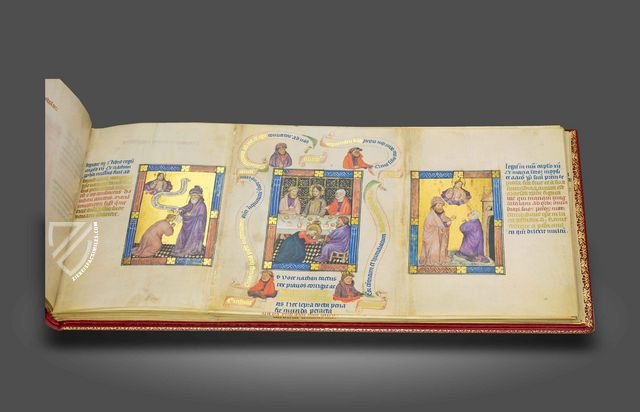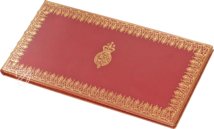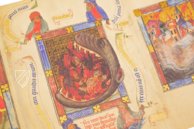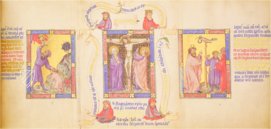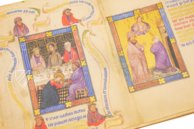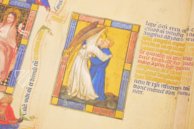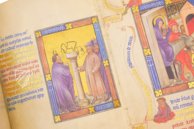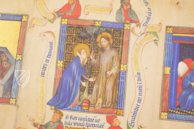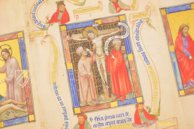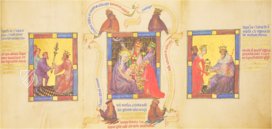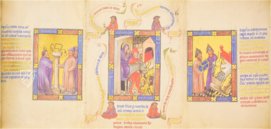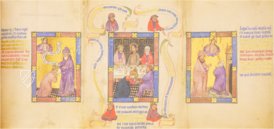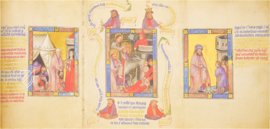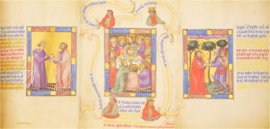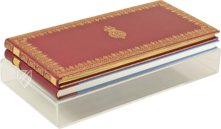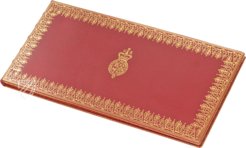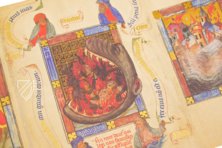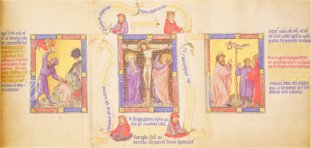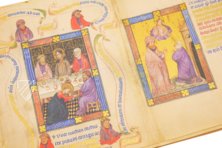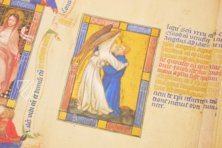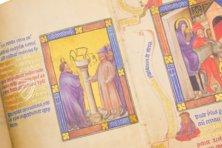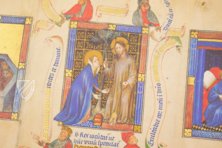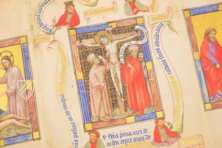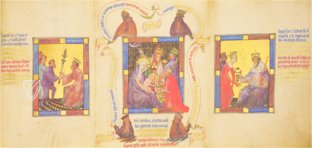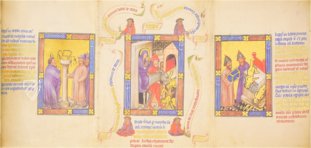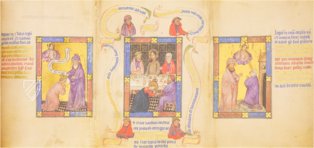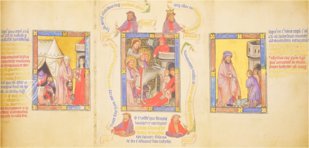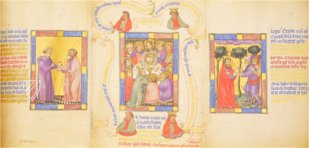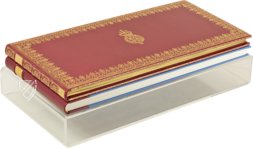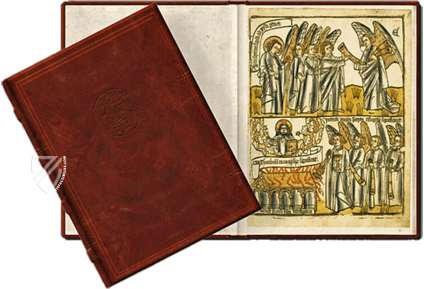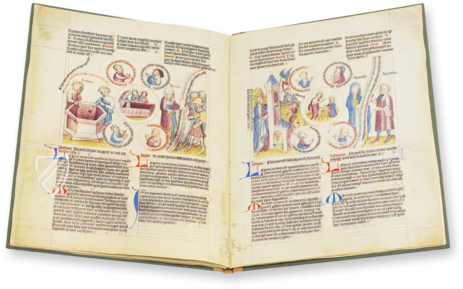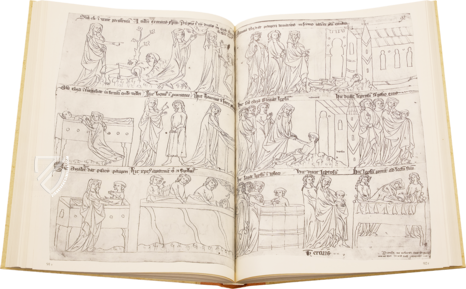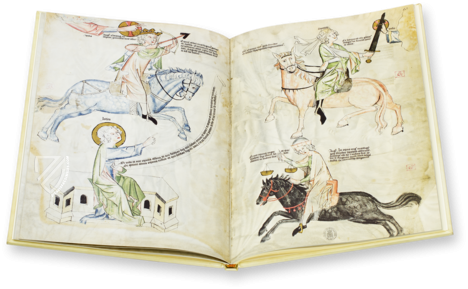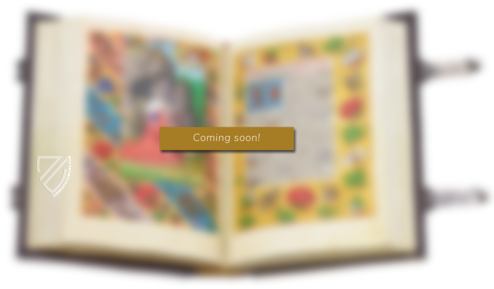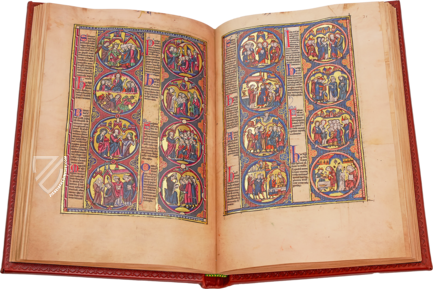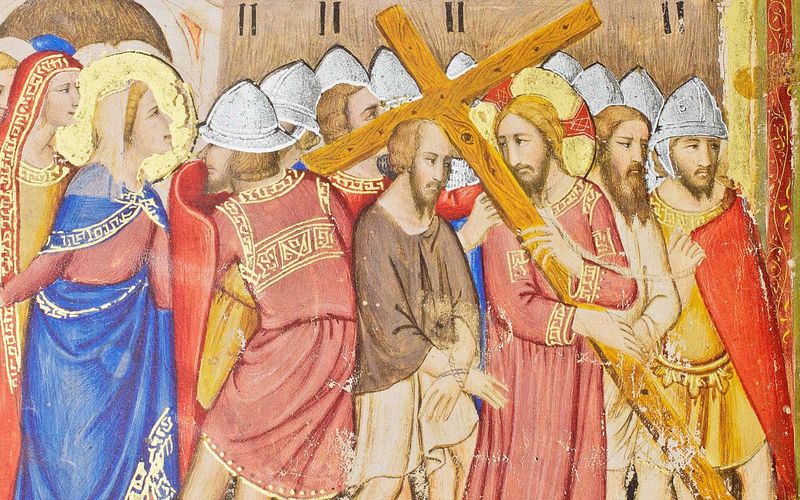Golden Bible - Biblia Pauperum
(1,000€ - 3,000€)
The Golden Bible - Biblia Pauperum is anything but a “Paupers' Bible”. Created around 1400, the codex appears in a highly unusual landscape format and is richly decorated with gold and silver throughout - befitting its content. The manuscript not only recounts the stories of the New Testament in 31 elaborate miniatures, but also visually links them to the events of the Old Testament and thus interprets the life of Christ in terms of salvation history. Yet the Gothic masterpiece requires hardly any text; the 93 images literally say more than a thousand words and turn each page of the magnificent manuscript into a small work of art in its own right. This gem was probably created for Duke Albert I of Bavaria (1336-1404) or his wife Margaret of Cleves (around 1375-1411) by the so-called Master of Margaret of Cleves' Book of Hours, who worked at their court in The Hague. Through the vagaries of history, the exquisite manuscript finally came into the possession of the English King George III in the 18th century.
The Golden Picture Bible “Biblia Pauperum”
A codex arose at the beginning of the 15th century in an unusual form, which told the stories of the Holy Scripture in captioned pictures. The illustrated book showed expensively gilded scenes from the New Testament, which were accompanied by clarifying images from the Old Testament. The work contains 93 images of gold and silver bedecked miniatures, of which there are three on each page. The middle image always contained an event from the New Testament that are framed by drawings of busts of the prophets. Depictions from the Old Testament are to be found the right and left of these scenes, respectively, that are to be considered as forerunners for the New Testament events. An example of this is found in the fourth page of the book, depicting the flight of Mary and Joseph with Jesus as a child. To the left of this scene one finds an image that shows the flight of Joseph to his uncle Laban, and to the right, an image of St. Michael as he aided David in his flight from Saul. In this way, an explanatory correlation between the biblical stories of the New and Old Testaments was manufactured.
The Master Remains Unknown
The Golden Bible was most likely created by an artist, who was active at the court of Count Albrecht von Bayern-Holland and his second wife Margaretha von Kleve in the early years of the 15th century. Judging by remarkable similarities in the artwork, it is very likely to have been the same artist who is responsible for the creation of Margaretha’s book of hours, it cannot be a mere coincidence. The illuminator wanted his work to have a very specific purpose. Heretics, such as the Cathars, which attracted more and more followers at the end of the Middle Ages, were to be confronted with such a fine biblical text. Their dangerous ideas, which brought the prevailing Christian world view into question, were to be refuted using an artistically appealing manner.
A Turbulent History
After the picture Bible was finished, it disappeared for nearly three centuries and its abode in this time has still not been fully clarified today. Its name is recorded in a 16th century book, namely the Ratclyff Boke. It was verifiably transmitted from this lord to an English noblemen in Lancashire. A descendant of this family gifted the book in the 18th century to King George III. At this time, the bible was furnished with a red leather binding from Morocco and gold embossing. In 1823, the entire library of King George III was given over to the state by his son. Today the book is to be found in the British Library in London.
Definitely Not a Poor Man’s Bible
The codex only has the affixed name Biblia Pauperum through a chance accident. Although the poor at the end of the Middle Ages were still mostly illiterate, illustrated books were used to disseminate biblical texts. The Golden Bible can hardly be considered a work that was intended for the lower classes because of its opulent gilding. The magnificent, vividly colored, and richly bedecked with gold and silver miniatures evince the talent of its master and indicate a princely commissioner. The large format of the biblical scenes is particularly appealing, for which the painter chose a width of 18 centimeters and a height of nearly 40 centimeters for his picture bible. This format is truly unusual. The long, landscape formatted pages are particularly enjoyable for the modern beholder to read and discover.
Codicology
- Alternative Titles
- Goldene Bilderbibel - Biblia Pauperum
- Size / Format
- 70 pages / 17.9 × 38.4 cm
- Origin
- Netherlands
- Date
- Ca. 1395–1405
- Epochs
- Style
- Genre
- Language
- Script
- Gothic Textura Quadrata
- Illustrations
- 93 miniatures preserved (out of at least 99 originally); 31 New Testament and 62 Old Testament
- Content
- Picture Bible
- Patron
- Albert I, Duke of Bavaria (1336–1404), or his second wife Margaret of Cleves (ca. 1375–1411)
- Artist / School
- Master of Margaret of Cleves' Book of Hours
- Previous Owners
- Ratclyff family
King George III of England (1738–1820)
George IV of England (1762–1830)
Golden Bible - Biblia Pauperum
Harrowing of Hell
Staff in hand, Christ reaches out to the denizens of Hell, depicted in typical fashion as the mouth of a great monster – the Hellmouth. This common scene occurring between the Crucifixion and Resurrection shows Christ proclaiming good tidings to the dead and bringing salvation to all the righteous who have died since the beginning of the world. The miniature is almost completely symmetrical, divided between the gaping Hellmouth and background of tiles with delicate patterns in gold ink.
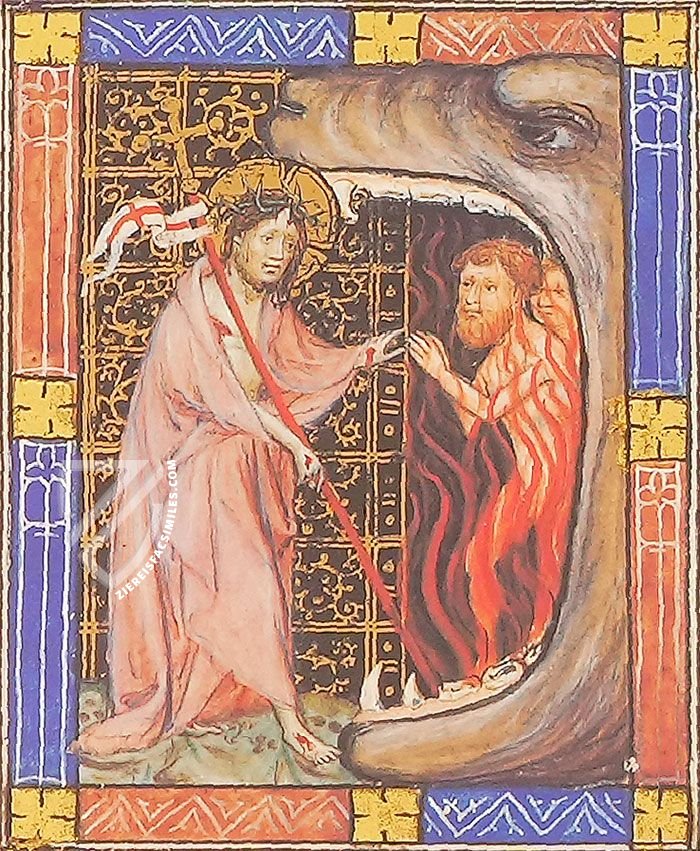
Golden Bible - Biblia Pauperum
The Resurrection
A rare landscape format allows for interesting compositions like this. As was typical in Gothic manuscripts, a primary scene from the New Testament is juxtaposed with scenes from the Old Testament with which it shares some common message. Here, the Resurrection is flanked to the left by a miniature of Samson carrying off the gates of Gaza and to the right by Jonah, who has just been spit up by the wale.
All three images have similar frames of red, blue, and gold, the two Old Testament scenes feature burnished gold backgrounds while the Resurrection is presented before a fine pattern of dark blue and gold. Deliverance is the common theme: Jesus is released from death, Samson escapes his enemies, and Jonas is liberated from the belly of the whale.

#1 Goldene Bilderbibel - Biblia Pauperum
Languages: English, French, German
(1,000€ - 3,000€)
- Treatises / Secular Books
- Apocalypses / Beatus
- Astronomy / Astrology
- Bestiaries
- Bibles / Gospels
- Chronicles / History / Law
- Geography / Maps
- Saints' Lives
- Islam / Oriental
- Judaism / Hebrew
- Single Leaf Collections
- Leonardo da Vinci
- Literature / Poetry
- Liturgical Manuscripts
- Medicine / Botany / Alchemy
- Music
- Mythology / Prophecies
- Psalters
- Other Religious Books
- Games / Hunting
- Private Devotion Books
- Other Genres
- Afghanistan
- Armenia
- Austria
- Belgium
- Belize
- Bosnia and Herzegovina
- China
- Colombia
- Costa Rica
- Croatia
- Cyprus
- Czech Republic
- Denmark
- Egypt
- El Salvador
- Ethiopia
- France
- Germany
- Greece
- Guatemala
- Honduras
- Hungary
- India
- Iran
- Iraq
- Israel
- Italy
- Japan
- Jordan
- Kazakhstan
- Kyrgyzstan
- Lebanon
- Liechtenstein
- Luxembourg
- Mexico
- Morocco
- Netherlands
- Palestine
- Panama
- Peru
- Poland
- Portugal
- Romania
- Russia
- Serbia
- Spain
- Sri Lanka
- Sweden
- Switzerland
- Syria
- Tajikistan
- Turkey
- Turkmenistan
- Ukraine
- United Kingdom
- United States
- Uzbekistan
- Vatican City
- A. Oosthoek, van Holkema & Warendorf
- Aboca Museum
- Ajuntament de Valencia
- Akademie Verlag
- Akademische Druck- u. Verlagsanstalt (ADEVA)
- Aldo Ausilio Editore - Bottega d’Erasmo
- Alecto Historical Editions
- Alkuin Verlag
- Almqvist & Wiksell
- Amilcare Pizzi
- Andreas & Andreas Verlagsbuchhandlung
- Archa 90
- Archiv Verlag
- Archivi Edizioni
- Arnold Verlag
- ARS
- Ars Magna
- ArtCodex
- AyN Ediciones
- Azimuth Editions
- Badenia Verlag
- Bärenreiter-Verlag
- Belser Verlag
- Belser Verlag / WK Wertkontor
- Benziger Verlag
- Bernardinum Wydawnictwo
- BiblioGemma
- Biblioteca Apostolica Vaticana (Vaticanstadt, Vaticanstadt)
- Bibliotheca Palatina Faksimile Verlag
- Bibliotheca Rara
- Boydell & Brewer
- Bramante Edizioni
- Bredius Genootschap
- Brepols Publishers
- British Library
- C. Weckesser
- Caixa Catalunya
- Canesi
- CAPSA, Ars Scriptoria
- Caratzas Brothers, Publishers
- Carus Verlag
- Casamassima Libri
- Centrum Cartographie Verlag GmbH
- Chavane Verlag
- Christian Brandstätter Verlag
- Circulo Cientifico
- Club Bibliófilo Versol
- Club du Livre
- CM Editores
- Collegium Graphicum
- Collezione Apocrifa Da Vinci
- Comissão Nacional para as Comemorações dos Descobrimentos Portugueses
- Coron Verlag
- Corvina
- CTHS
- D. S. Brewer
- Damon
- De Agostini/UTET
- De Nederlandsche Boekhandel
- De Schutter
- Deuschle & Stemmle
- Deutscher Verlag für Kunstwissenschaft
- DIAMM
- Droz
- E. Schreiber Graphische Kunstanstalten
- Ediciones Boreal
- Ediciones Grial
- Ediclube
- Edições Inapa
- Edilan
- Editalia
- Edition Deuschle
- Edition Georg Popp
- Edition Leipzig
- Edition Libri Illustri
- Editiones Reales Sitios S. L.
- Éditions de l'Oiseau Lyre
- Editions Medicina Rara
- Editorial Casariego
- Editorial Mintzoa
- Editrice Antenore
- Editrice Velar
- Edizioni Edison
- Egeria, S.L.
- Eikon Editores
- Electa
- Emery Walker Limited
- Enciclopèdia Catalana
- Eos-Verlag
- Ephesus Publishing
- Ernst Battenberg
- Eugrammia Press
- Extraordinary Editions
- Fackelverlag
- Facsimila Art & Edition
- Facsimile Editions Ltd.
- Facsimilia Art & Edition Ebert KG
- Faksimile Verlag
- Feuermann Verlag
- Folger Shakespeare Library
- Franco Cosimo Panini Editore
- Friedrich Wittig Verlag
- Fundación Hullera Vasco-Leonesa
- G. Braziller
- Gabriele Mazzotta Editore
- Gebr. Mann Verlag
- Gesellschaft für graphische Industrie
- Getty Research Institute
- Giovanni Domenico de Rossi
- Giunti Editore
- Graffiti
- Grafica European Center of Fine Arts
- Guido Pressler
- Guillermo Blazquez
- Gustav Kiepenheuer
- H. N. Abrams
- Harrassowitz
- Harvard University Press
- Helikon
- Hendrickson Publishers
- Henning Oppermann
- Herder Verlag
- Hes & De Graaf Publishers
- Hoepli
- Holbein-Verlag
- Houghton Library
- Hugo Schmidt Verlag
- Idion Verlag
- Il Bulino, edizioni d'arte
- ILte
- Imago
- Insel Verlag
- Insel-Verlag Anton Kippenberger
- Instituto de Estudios Altoaragoneses
- Instituto Nacional de Antropología e Historia
- Istituto dell'Enciclopedia Italiana - Treccani
- Istituto Ellenico di Studi Bizantini e Postbizantini
- Istituto Geografico De Agostini
- Istituto Poligrafico e Zecca dello Stato
- Italarte Art Establishments
- Jan Thorbecke Verlag
- Johnson Reprint Corporation
- Josef Stocker
- Josef Stocker-Schmid
- Jugoslavija
- Karl W. Hiersemann
- Kasper Straube
- Kaydeda Ediciones
- Kindler Verlag / Coron Verlag
- Kodansha International Ltd.
- Konrad Kölbl Verlag
- Kurt Wolff Verlag
- La Liberia dello Stato
- La Linea Editrice
- La Meta Editore
- Lambert Schneider
- Landeskreditbank Baden-Württemberg
- Leo S. Olschki
- Les Incunables
- Liber Artis
- Library of Congress
- Libreria Musicale Italiana
- Lichtdruck
- Lito Immagine Editore
- Lumen Artis
- Lund Humphries
- M. Moleiro Editor
- Maison des Sciences de l'homme et de la société de Poitiers
- Manuscriptum
- Martinus Nijhoff
- Maruzen-Yushodo Co. Ltd.
- MASA
- Massada Publishers
- McGraw-Hill
- Metropolitan Museum of Art
- Militos
- Millennium Liber
- Müller & Schindler
- Nahar - Stavit
- Nahar and Steimatzky
- National Library of Wales
- Neri Pozza
- Nova Charta
- Oceanum Verlag
- Odeon
- Orbis Mediaevalis
- Orbis Pictus
- Österreichische Staatsdruckerei
- Oxford University Press
- Pageant Books
- Parzellers Buchverlag
- Patrimonio Ediciones
- Pattloch Verlag
- PIAF
- Pieper Verlag
- Plon-Nourrit et cie
- Poligrafiche Bolis
- Presses Universitaires de Strasbourg
- Prestel Verlag
- Princeton University Press
- Prisma Verlag
- Priuli & Verlucca, editori
- Pro Sport Verlag
- Propyläen Verlag
- Pytheas Books
- Quaternio Verlag Luzern
- Reales Sitios
- Recht-Verlag
- Reichert Verlag
- Reichsdruckerei
- Reprint Verlag
- Riehn & Reusch
- Roberto Vattori Editore
- Rosenkilde and Bagger
- Roxburghe Club
- Salerno Editrice
- Saltellus Press
- Sandoz
- Sarajevo Svjetlost
- Schöck ArtPrint Kft.
- Schulsinger Brothers
- Scolar Press
- Scrinium
- Scripta Maneant
- Scriptorium
- Shazar
- Siloé, arte y bibliofilia
- SISMEL - Edizioni del Galluzzo
- Sociedad Mexicana de Antropología
- Société des Bibliophiles & Iconophiles de Belgique
- Soncin Publishing
- Sorli Ediciones
- Stainer and Bell
- Studer
- Styria Verlag
- Sumptibus Pragopress
- Szegedi Tudomànyegyetem
- Taberna Libraria
- Tarshish Books
- Taschen
- Tempus Libri
- Testimonio Compañía Editorial
- Thames and Hudson
- The Clear Vue Publishing Partnership Limited
- The Facsimile Codex
- The Folio Society
- The Marquess of Normanby
- The Richard III and Yorkist History Trust
- Tip.Le.Co
- TouchArt
- TREC Publishing House
- TRI Publishing Co.
- Trident Editore
- Tuliba Collection
- Typis Regiae Officinae Polygraphicae
- Union Verlag Berlin
- Universidad de Granada
- University of California Press
- University of Chicago Press
- Urs Graf
- Vallecchi
- Van Wijnen
- VCH, Acta Humaniora
- VDI Verlag
- VEB Deutscher Verlag für Musik
- Verlag Anton Pustet / Andreas Verlag
- Verlag Bibliophile Drucke Josef Stocker
- Verlag der Münchner Drucke
- Verlag für Regionalgeschichte
- Verlag Styria
- Vicent Garcia Editores
- W. Turnowski Ltd.
- W. Turnowsky
- Waanders Printers
- Wiener Mechitharisten-Congregation (Wien, Österreich)
- Wissenschaftliche Buchgesellschaft
- Wissenschaftliche Verlagsgesellschaft
- Wydawnictwo Dolnoslaskie
- Xuntanza Editorial
- Zakład Narodowy
- Zollikofer AG

